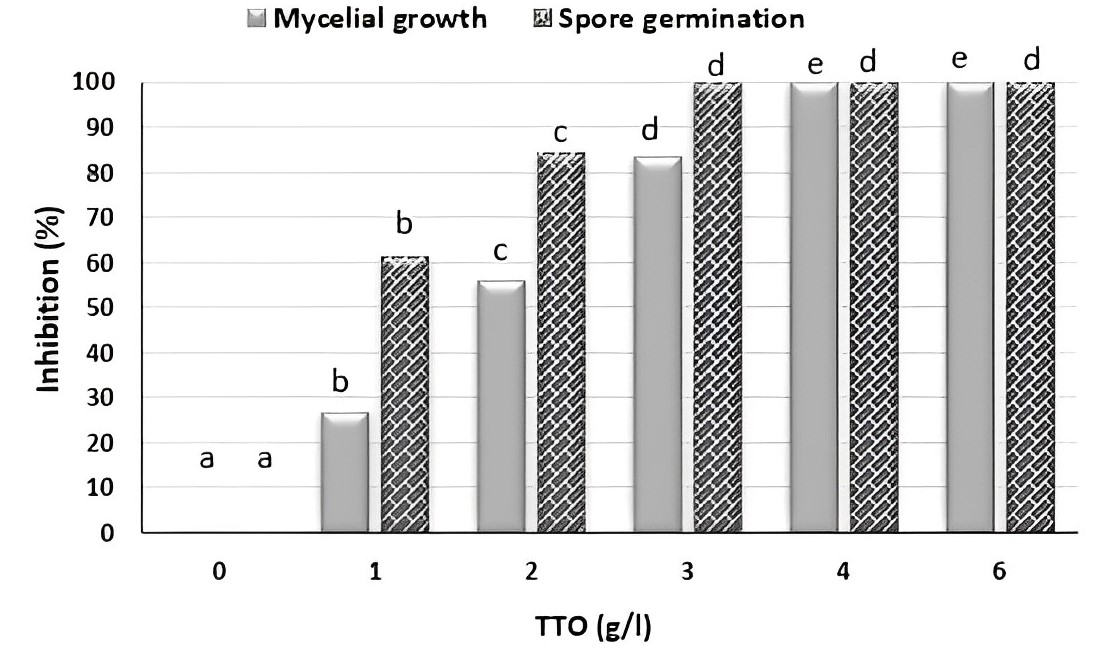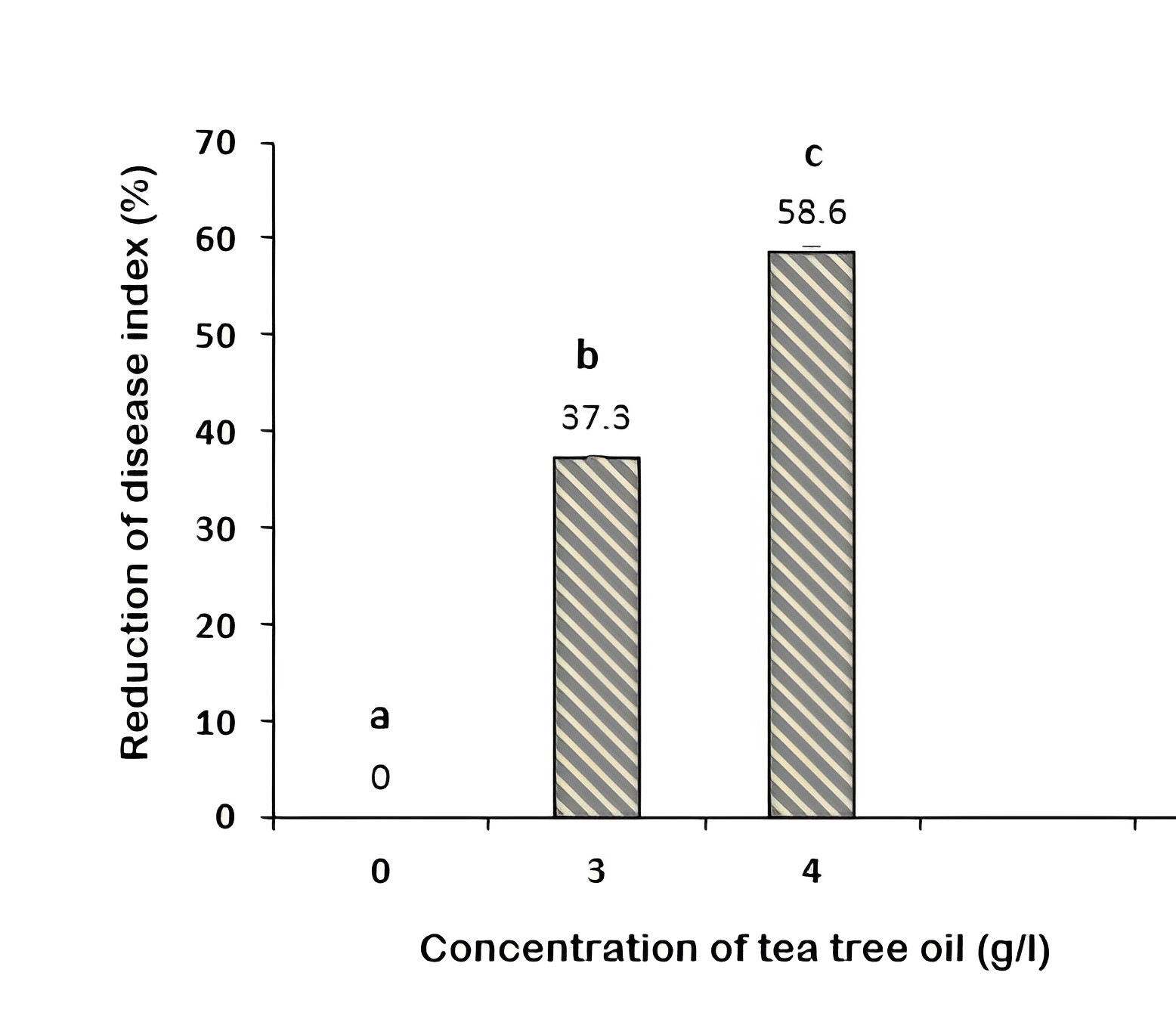TEA TREE ESSENTIAL OIL INDUCES RESISTANCE AGAINST TUBER ROT CAUSED BY ALTERNARIA ALTERNATA DURING POTATO STORAGE
TEA TREE ESSENTIAL OIL INDUCES RESISTANCE AGAINST TUBER ROT CAUSED BY ALTERNARIA ALTERNATA DURING POTATO STORAGE
Abstract
One of the main potato diseases during storage is Alternaria tuber rot (early blight), caused by the fungus Alternaria alternata, resulting in significant economic losses. Plant essential oils could be an eco-friendly alternative to synthetic fungicides for the control of postharvest diseases on agricultural produces. The objective of this study was to evaluate the antifungal activity, the control of Alternaria tuber rot, and the activity of defense enzymes in potato tubers treated with tea tree essential oil (TTO) of Melaleuca alternifolia. Application of 0.0-6.0 g/l TTO significantly inhibited mycelial growth and spore germination of A. alternata in vitro, with the greatest inhibitory effect observed at 3.0 and 4.0 g/l against spore germination and mycelial growth, respectively. TTO at 4.0 g/l showed an effective reduction in disease index 58.6% of A. alternata after 21 days of storage at 25°C. An increase in peroxidase (POD) and phenylalanine ammonia-lyase (PAL) activities were observed in the potato tubers. TTO can be an alternative for the control of Alternaria tuber rot.
1. Introduction
In Russia, potato is called the "second bread". It is a widely grown agricultural crop, used both fresh and for processing into potato products such as chips, French fries, mashed potatoes, starch, alcohol, and fodder. Potato has rich vitamins, and antioxidants contents .
Early blight (EB) represents a devastating potato disease in most potato-growing countries . The phytopathogen of EB contains varied species of Alternaria genus, These species vary dependent on geographical cultivation regions. Many researchers recorded specific Alternaria species on potato, for example, A. solani Sorauer, A. tenuissima, A. grandis Simmons, A. protenta, A. alternata. The symptoms appear during vegetation, and the tubers can be infected, leading to dry rot during storage . In different countries, EB causes annual yield losses up to 58% , and losses during storage reached up to 30% . Pesticides application is a primary management option in controlling potato diseases. Although, because of public health concerns, and preservation of the environment, alternative methods are needed to combat these phytopathogens.
Chemicals can be replaced by botanical-derived products like plant-based extracts and essential oils . These environmentally friendly substances are less harmful to the environment, do not contaminate food with pesticides, reducing the human poisoning risk, and limiting the spread of resistant plant diseases . Because essential oils EOs are sources of physiologically active molecules in various patho-systems, their diversity allows them to regulate plant pathogens by direct fungitoxic activity, and resistance induction . Many EOs were employed in the agricultural sector to prevent post-harvest losses on various crops . Melaleuca alternifolia essential oil (TTO) can be a preservation agent, fungicide, aromatherapy, allopathic and herbal remedies, among other things .
The research objective is investigating TTO's fungicidal action on Alternaria tuber rot during potato storage.
2. Pathogen and TTO
Alternaria alternata isolated from diseased tubers from a previous study was used in current research. TTO was manufactured by NRC, Egypt, by steam distillation extraction technique.
2.1. In vitro experiments
The agar dilution method (contact phase) was used to test TTO's fungicidal effectiveness on mycelial growth of A. alternata . TTO in various quantities was mixed in sterile PDA media containing 0.05% (v/v) Tween-80 as an emulsion immediately before it was poured into petri dishes (90 mm diameter) to obtain final oil concentrations (0.0-6.0 g/l). Control traits contain medium amended with Tween-80, but without oil. Petri plates inoculated with a five-millimeter plug of the pathogen. After 7-days incubation at 25°C, the percentage of mycelial growth inhibition was assessed according to , and calculating as follows:
Where C and T are the radial growth (mm) of fungal colony in the control and treatments, respectively.
For spore viability assay: 0.5 ml aliquots of the spore suspension (containing 104 spores ml-1) were placed in 2 ml sterilized Eppendorf tubes containing PDB media with the above-mentioned concentrations of TTO with 0.05% Tween-80 as emulsifying agent, then incubated at 25°C/12 hr. Germination was regarded when the germ tube length exceeds the spore diameter , and calculated using the formula given by as follows:
2.2. In vivo experiments. Disease index on tubers
Tubers of cultivar “Rivera” were used to validate the in vitro results. After rinsing the tubers with tap water, and sterilizing with sodium hypochlorite (2%) for three minutes, then washed by sterilized water. Tubers were wounded with a 5×5 mm (diameter × depth) using a sterile cork borer, then tubers were treated 2 hours before infection with A. alternata by spraying the whole tuber with 3.0 or 4.0 g/l TTO, after that tubers inoculated by deposing in the occasioned hole a 5 mm-agar plug of A. alternata removed from an active culture at 25°C. The control traits (infected tubers) received sterilized distilled water (with Tween-80). All treatments were kept at 25°C and moderately high humidity for 21 days. Each treatment had ten tubers with four replicates . Tubers were sliced through the inoculation site and the depth and width of the rot region after storage, and tubers' length and width were measured. The disease index (X) according to calculated by the formula:
where:
d – lesion width (mm);
h – lesion depth (mm);
D - tuber length (mm);
H - tuber width (mm).
2.3. Defense enzymes assay
TTO activity on the defense enzymes, peroxidase POD, and phenylalanine ammonia-lyase PAL was measured in potato tuber tissues samples collected (0-4 days) after treatments (using 4.0 g/l of TTO, which was the concentration that showed the total inhibition of mycelial growth and spore germination). The crude enzyme was extracted according to (0-4 days) after treatments. POD, and PAL activity were determined as described by , . The total protein content was measured by Bradford method (1976) using bovine serum albumin as a standard .
A one-way analysis of variance (ANOVA) was performed on the data. LSD test was used to separate means, using (CoStat 6.45 software package), significance was defined as P <0.05.
3. Results and discussion
3.1. In vitro experiments
The results of TTO fungicidal activities are shown in Figure 1. The results show that different TTO concentrations significantly inhibited mycelial growth (15.2-100%) and spore germination (61.4-100%). When compared to the control, the highest concentration 4.0 g/l inhibited mycelial growth, and spore germination completely. These results are consistent with those obtained by , who reported that TTO at 2.0 g/l inhibited A. solani by 44.71%, and who indicated that TTO at 0.4% inhibited A. alternata mycelium by 100%. The inhibition rate reached up to 80% when B. cinerea, and R. stolonifer were treated by TTO at 1000 mg/l .

Figure 1 - Effect of TTO different concentrations on inhibition of mycelial growth and spore germination of A. alternata
Note: columns (from the same type) followed by different letters are significantly different according to LSD test at P < 0.05
3.2. In vivo experiments. Disease index on tubers
Figure 2 shows TTO treatment's effect on the disease index in tubers after 21 days /25°C. The disease index decreased gradually throughout, increasing TTO concentrations. The disease index in tubers treated with TTO at 4.0 g/l was reduced by 58.6%. TTO was found to lengthen the shelf life of citrus (against P. italicum) and strawberry (against B. cinerea, and R. stolonifera) , .

Figure 2 - Effect of TTO different concentrations on reduction of disease index in potato tubers infected with A. alternata
Note: columns followed by different letters are significantly different according to LSD test at P < 0.05
When we treated potato tubers with TTO, we noticed that the activity of POD reached its highest value during the fourth day in comparison to the control (Tab. 1). PAL activity kept going up for three days. It was about 1.5 times higher than the control group. But then on the fourth day, it started to go down. However, the enzyme activity of POD and PAL in the treated group stayed higher than the control group for the whole time of the experiment (Tab. 1).
Table 1 - Effect of TTO (4.0 g/l) on POD, and PAL activities in potato tubers infected with A. alternata during 0-4 days of storage
Treatments | POD activity (U mg-1 protein min-1) | PAL activity (U mg-1 protein min-1) | ||||||||
0* | 1 | 2 | 3 | 4 | 0* | 1 | 2 | 3 | 4 | |
Control | 3.26 ±0.20h | 4.03 ±0.15g | 4.46 ±0.35g | 7.73 ±0.20e | 8.33 ±0.49d | 2.36 ±0.14s | 3.97 ±0.07h | 8.34 ±0.40e | 13.33 ±0.16c | 7.24 ±0.17f |
TTO (4.0 g/l) | 3.26 ±0.20h | 6.63± 0.37f | 9.30 ±0.43c | 12.23 ±0.32b | 13.13 ±0.15a | 2.36 ±0.14s | 5.52 ±0.05g | 14.67 ±0.09b | 19.89 ±0.11a | 12.54 ±0.19d |
LSD 0.05 | 0.53 | 0.32 | ||||||||
Note: values followed by different letters are significantly different according to LSD test at P < 0.05
* Days after treatment (0-4 days)
Recent research indicated TTO can manage Alternaria rot in tubers by induction of defense enzymes such as PAL and POD. observed an increase in PAL and POD activities in the tomato leaves infected with Alternaria solani and treated with TTO. The biosynthesis of lignin by the phenylpropanoid pathway depends on specific enzymes including PAL, and POD as well as the participation of H2O2 . Thus, a resistance inducer action can make it difficult for the pathogen to penetrate the cell wall, promoting greater resistance against the pathogens' toxins .
4. Conclusion
Application of 0.0-6.0 g/l TTO significantly inhibited mycelial growth and spore germination of A. alternata in vitro, with the greatest inhibitory effect observed at 3.0 and 4.0 g/l against spore germination and mycelial growth, respectively. TTO at 4.0 g/l showed an effective reduction in disease index 58.6% of A. alternata after 21 days of storage at 25°C. An increase in peroxidase (POD) and phenylalanine ammonia-lyase (PAL) activities were observed in the potato tubers. TTO can be an alternative for the control of Alternaria tuber rot.
